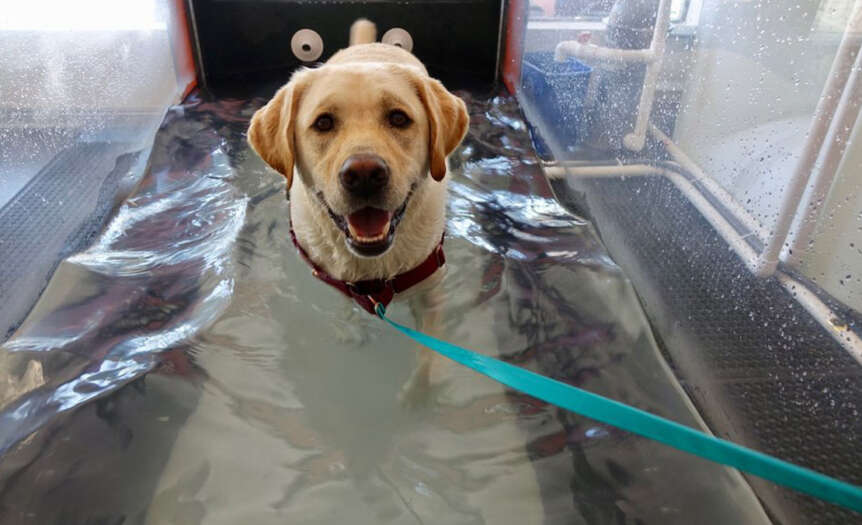Nowadays, therapists, sport coaches and trainers understand the benefits of aquatic therapy for people. The benefits for dogs are also well documented and are strongly supported by the Canine Sport Medicine and Rehabilitation field of veterinary medicine. For dogs, aquatic therapy refers mainly to therapy in an underwater treadmill (UWTM). This mode of therapy, where the patient is entered in a huge water tank with a treadmill at the bottom, was first developed for racing horses in the 1970s. It was later introduced as a physical therapy tool for people in the mid-1980s. Finally, it was developed for dogs at the end of the 1990s.
Why is the UWTM such an important tool for canine physical therapy? Therapy in a UWTM allows the performance of exercises for balance and movement safely and pain-free, well before the exercises can be attempted on land. For this reason, it is an ideal modality following orthopedic surgery, allowing the dog to return to normal functional mobility early in the postsurgical period. For neurological patients unable to walk, the UWTM therapy reduces the atrophying effects of immobility while facilitating proprioceptive gait training (awareness of one’s limbs in space), speeds gait training and improves the active range of motion of all joints as compared to land exercises. For arthritic senior pets, the UWTM therapy will improve balance and coordination while strengthening the muscles and enhancing cardio endurance. Athletic dogs will strengthen muscles and improve their muscle and cardiopulmonary endurance, which translates to improved performance in competitions. The UWTM also represents an important part of an effective weight loss program for obese dogs, raising their metabolic rate and improving their ability to burn fat. An advantage of the UWTM therapy is that it gives the therapist the option to change water depth, resistance and speed of the treadmill as needed. These variables allow a consistently progressive physical therapy plan to be implemented. In addition, the warm water temperature offers soothing muscle relaxation. Assistive devices and modalities — such as elastic bands, flippers, tail work, water currents through use of jets, manual therapies and massage, to name a few — are frequently employed while performing therapy in the UWTM.
Interested? Before considering therapy in a UWTM, your best option is to have your dog evaluated by a licensed veterinarian certified in canine rehabilitation and with vast experience in UWTM therapy. This is critical in the case of geriatric dogs, dogs with concurrent medical conditions and simply for peace of mind. A complete medical history that includes medical diagnosis, prescribed medications, supplements, past surgeries and sports injuries is required. A complete exam from the perspective of a physical therapist is essential. A clinical assessment and a water therapy customized plan will be formulated. Measurable outcome goals will be established. The dog will be reassessed periodically, and the water therapy will be modified according to the dog’s progress until the rehabilitation goals are reached. Each therapeutic program is individualized and cannot be preformulated. A maintenance program can be initiated once the water rehabilitation goals have been reached or as a way of cross-training. UWTM is also a valid feline physical therapy modality for cats that are comfortable in water.
The properties of water (buoyancy, hydrostatic pressure, fluid dynamics and resistance) make UWTM therapy an excellent tool for achieving canine physical therapy goals and maintaining total body fitness. UWTM therapy has been an integral part of our animal physical therapy services for 13 years. We invite you to visit us for a demonstration or to inquire if your pet might benefit from this modality.














 Deering Estate
Deering Estate
 Massage Envy South Miami
Massage Envy South Miami
 Calla Blow Dry
Calla Blow Dry
 My Derma Clinic
My Derma Clinic
 Sushi Maki
Sushi Maki
 Sports Grill
Sports Grill
 The Healthy Kitchen
The Healthy Kitchen
 Golden Rule Seafood
Golden Rule Seafood
 Malanga Cuban Café
Malanga Cuban Café

 Kathleen Ballard
Kathleen Ballard
 Panter, Panter & Sampedro
Panter, Panter & Sampedro
 Vintage Liquors
Vintage Liquors
 The Dog from Ipanema
The Dog from Ipanema
 Rubinstein Family Chiropractic
Rubinstein Family Chiropractic
 Your Pet’s Best
Your Pet’s Best
 Indigo Republic
Indigo Republic




 ATR Luxury Homes
ATR Luxury Homes


 2112 Design Studio
2112 Design Studio
 Hamilton Fox & Company
Hamilton Fox & Company
 Creative Design Services
Creative Design Services
 Best Pest Professionals
Best Pest Professionals
 HD Tree Services
HD Tree Services
 Trinity Air Conditioning Company
Trinity Air Conditioning Company
 Cisca Construction & Development
Cisca Construction & Development
 Mosquito Joe
Mosquito Joe
 Cutler Bay Solar Solutions
Cutler Bay Solar Solutions


 Miami Royal Ballet & Dance
Miami Royal Ballet & Dance
 Christopher Columbus
Christopher Columbus
 Pineview Preschools
Pineview Preschools
 Westminster
Westminster
 Carrollton
Carrollton
 Lil’ Jungle
Lil’ Jungle
 Frost Science Museum
Frost Science Museum
 Palmer Trinity School
Palmer Trinity School
 South Florida Music
South Florida Music
 Pinecrest Orthodontics
Pinecrest Orthodontics
 Dr. Bob Pediatric Dentist
Dr. Bob Pediatric Dentist
 d.pediatrics
d.pediatrics
 South Miami Women’s Health
South Miami Women’s Health

 The Spot Barbershop
The Spot Barbershop
 My Derma Clinic
My Derma Clinic




 Miami Dance Project
Miami Dance Project

 Rubinstein Family Chiropractic
Rubinstein Family Chiropractic
 Indigo Republic
Indigo Republic

 Safes Universe
Safes Universe
 Vintage Liquors
Vintage Liquors
 Evenings Delight
Evenings Delight





 Atchana’s Homegrown Thai
Atchana’s Homegrown Thai
 Baptist Health South Florida
Baptist Health South Florida

 Laser Eye Center of Miami
Laser Eye Center of Miami
 Visiting Angels
Visiting Angels
 OpusCare of South Florida
OpusCare of South Florida

 Your Pet’s Best
Your Pet’s Best





 HD Tree Services
HD Tree Services
 Hamilton Fox & Company
Hamilton Fox & Company


 Creative Design Services
Creative Design Services